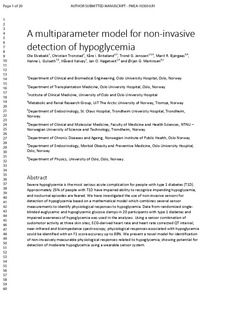| dc.contributor.author | Elvebakk, Ole | |
| dc.contributor.author | Tronstad, Christian | |
| dc.contributor.author | Birkeland, Kåre I. | |
| dc.contributor.author | Jenssen, Trond Geir | |
| dc.contributor.author | Bjørgaas, Marit Ragnhild Rokne | |
| dc.contributor.author | Gulseth, Hanne Løvdal | |
| dc.contributor.author | Kalvøy, Håvard | |
| dc.contributor.author | Høgetveit, Jan Olav | |
| dc.contributor.author | Martinsen, Ørjan Grøttem | |
| dc.date.accessioned | 2020-01-27T10:22:11Z | |
| dc.date.available | 2020-01-27T10:22:11Z | |
| dc.date.created | 2019-10-21T16:51:20Z | |
| dc.date.issued | 2019 | |
| dc.identifier.citation | Physiological Measurement. 2019, 40 (8), 1-14. | nb_NO |
| dc.identifier.issn | 0967-3334 | |
| dc.identifier.uri | http://hdl.handle.net/11250/2638014 | |
| dc.description.abstract | Objective: Severe hypoglycemia is the most serious acute complication for people with type 1 diabetes (T1D). Approximately 25% of people with T1D have impaired ability to recognize impending hypoglycemia, and nocturnal episodes are feared. Approach: We have investigated the use of non-invasive sensors for detection of hypoglycemia based on a mathematical model which combines several sensor measurements to identify physiological responses to hypoglycemia. Data from randomized single-blinded euglycemic and hypoglycemic glucose clamps in 20 participants with T1D and impaired awareness of hypoglycemia was used in the analyses. Main results: Using a sensor combination of sudomotor activity at three skin sites, ECG-derived heart rate and heart rate corrected QT interval, near-infrared and bioimpedance spectroscopy; physiological responses associated with hypoglycemia could be identified with an F1 score accuracy up to 88%. Significance: We present a novel model for identification of non-invasively measurable physiological responses related to hypoglycemia, showing potential for detection of moderate hypoglycemia using a wearable sensor system | nb_NO |
| dc.language.iso | eng | nb_NO |
| dc.publisher | IOP Publishing | nb_NO |
| dc.title | A multiparameter model for non-invasive detection of hypoglycemia | nb_NO |
| dc.type | Journal article | nb_NO |
| dc.type | Peer reviewed | nb_NO |
| dc.description.version | acceptedVersion | nb_NO |
| dc.source.pagenumber | 1-14 | nb_NO |
| dc.source.volume | 40 | nb_NO |
| dc.source.journal | Physiological Measurement | nb_NO |
| dc.source.issue | 8 | nb_NO |
| dc.identifier.doi | 10.1088/1361-6579/ab3676 | |
| dc.identifier.cristin | 1739238 | |
| dc.description.localcode | This is an author-created, un-copyedited version of an article accepted for publication/published in [Physiological Measurement ]. IOP Publishing Ltd is not responsible for any errors or omissions in this version of the manuscript or any version derived from it. The Version of Record is available online at [10.1088/1361-6579/ab3676] | nb_NO |
| cristin.unitcode | 194,65,15,0 | |
| cristin.unitcode | 1920,15,0,0 | |
| cristin.unitname | Institutt for klinisk og molekylær medisin | |
| cristin.unitname | Medisinsk klinikk | |
| cristin.ispublished | true | |
| cristin.fulltext | postprint | |
| cristin.qualitycode | 1 | |
